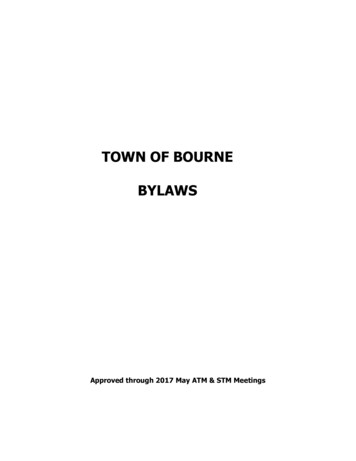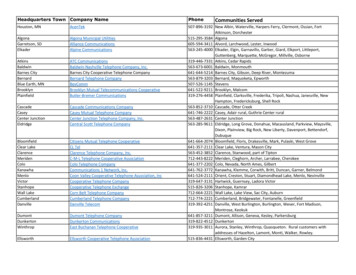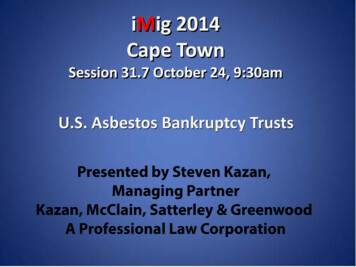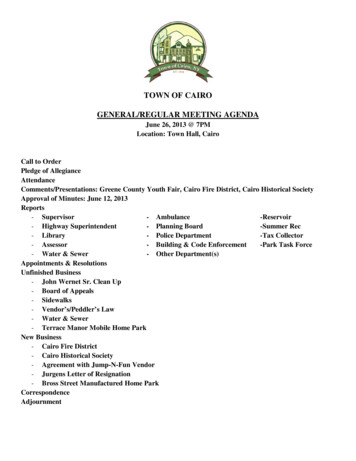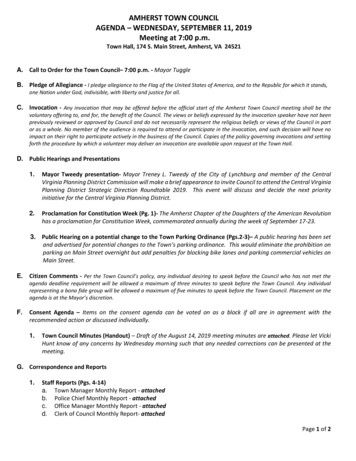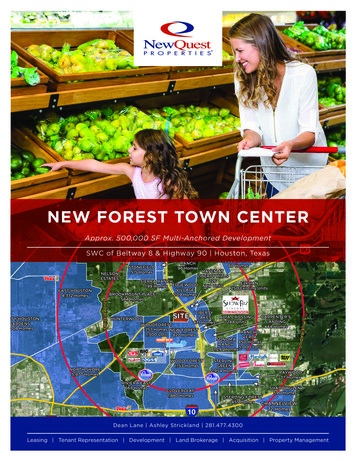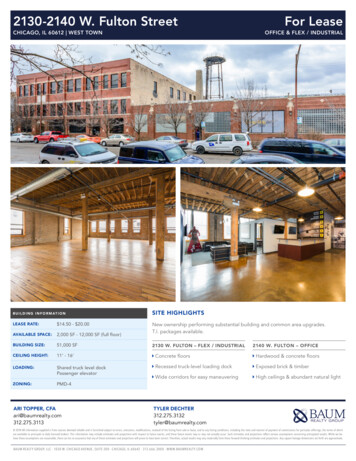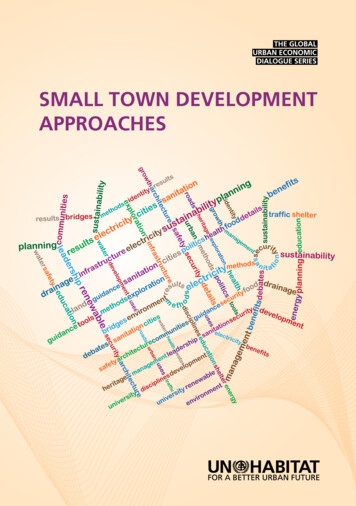
Transcription
Small Town DevelopmentApproaches
Small Town DevelopmentApproachesUnited Nations Human Settlements ProgrammeNairobi 2012i
The Global Urban Economic Dialogue SeriesSmall Town Development ApproachesFirst published in Nairobi in 2012 by UN-HABITAT.Copyright United Nations Human Settlements Programme 2012All rights reservedUnited Nations Human Settlements Programme (UN-HABITAT)P. O. Box 30030, 00100 Nairobi GPO KENYATel: 254-020-7623120 (Central Office)www.unhabitat.orgHS/025/12EISBN Number (Series): 978-92-1-132027-5ISBN Number (Volume): 978-92-1-132440-2DisclaimerThe designations employed and the presentation of the material in this publication do not imply theexpression of any opinion whatsoever on the part of the Secretariat of he United Nations concerning thelegal status of any country, territory, city or area r of its authorities, or concerning the delimitation of itsfrontiers of boundaries.Views expressed in this publication do not necessarily reflect those of the United NationsHuman Settlements Programme, the United Nations, or its Member States.Excerpts may be reproduced without authorization, on condition that the source is indicated.Acknowledgements:Director: Naison Mutizwa-MangizaChief Editor and Manager: Xing Quan ZhangPrincipal Author: William H. LambeContributors: Jaana Mioch, Ying He, Ji Yuan ShiEnglish Editor: Roman RollnickDesign and Layout: Freddie MaitariaAssistants: Agnes Ogana, Joy Muneneii
FOREWORDUrbanization is oneof the most powerful,irreversible forces in theworld. It is estimatedthat 93 percent ofthe future urbanpopulationgrowthwill occur in the citiesof Asia and Africa, andto a lesser extent, LatinAmerica and the Caribbean.We live in a new urban era with most ofhumanity now living in towns and cities.Global poverty is moving into cities, mostlyin developing countries, in a process we call theurbanisation of poverty.The world’s slums are growing and growingas are the global urban populations. Indeed,this is one of the greatest challenges we face inthe new millennium.The persistent problems of poverty and slumsare in large part due to weak urban economies.Urban economic development is fundamental toUN-HABITAT’s mandate. Cities act as enginesof national economic development. Strong urbaneconomies are essential for poverty reduction andthe provision of adequate housing, infrastructure,education, health, safety, and basic services.The Global Urban Economic Dialogue seriespresented here is a platform for all sectors of thesociety to address urban economic developmentand particularly its contribution to addressinghousing issues. This work carries many new ideas,solutions and innovative best practices fromsome of the world’s leading urban thinkers andpractitioners from international organisations,national governments, local authorities, theprivate sector, and civil society.This series also gives us an interesting insight anddeeper understanding of the wide range of urbaneconomic development and human settlementsdevelopment issues. It will serve UN member Stateswell in their quest for better policies and strategies toaddress increasing global challenges in these areasJoan ClosUnder-Secretary-General of the UnitedNations, Executive Director, UN-Habitatiii
iv
ContentsFOREWORDiiiINTRODUCTION 1Case Studies I:Case Studies iI:Case Studies iII:Case Studies IV:Entrepreneurship and small enterpriseincubation-based development3Brevard, North Carolina5Dillsboro, North Carolina7Fairfield, Iowa9Nelsonville, Ohio12Ord, Nebraska14Siler City, North Carolina17Place-based development21Bakersville and Hayesville, North Carolina23Big Stone Gap, Virginia26Black Mountain, North Carolina28Branson, Missouri30Colquitt, Georgia32Columbia, North Carolina34Edenton, North Carolina36Elkin, North Carolina38Hillsborough, North Carolina41Oakland, Maryland45Pelican Rapids, Minnesota47Star, North Carolina49Human capital-based development53Allendale, South Carolina55Houston, Minnesota57Morrilton, Arkansas59New York Mills, Minnesota61Rugby, North Dakota63Washington, North Carolina65Industry, high-tech, or manufacturing-baseddevelopment 67Cape Charles, Virginia69Douglas, Georgia71v
Etowah, Tennessee74Farmville, North Carolina77Oxford, North Carolina80Reynolds, Indiana82Conclusions and Lessons Learnedvi85
INTRODUCTIONENTREPRENEURSHIP AND SMALL ENTERPRISE INCUBATION-BASED DEVELOPMENTINTRODUCTIONFrom June 2006 to June 2007, researchers fromthe School of Government at the University ofNorth Carolina at Chapel Hill identified, studied,and documented fifty case studies of small townsacross the United States that are using a widerange of community and economic developmentstrategies to advance their communities’ visionfor prosperity. The case studies are a response todemand, from local public officials, for examplesof real communities facing challenges related toglobalization, geographic isolation, urban sprawl,aging populations and natural disasters. Casestudies were published in 2008 in a report entitledSmall Towns, Big Ideas: Case Studies in SmallTown Community and Economic Development.explicit goal of economic development is tomake measurable improvements to the economichealth of a particular jurisdiction. Equity, or thedistribution of economic benefits, is only implicitin most definitions of economic development.CED addresses equity explicitly because it is aprocess whereby a community realizes positivechanges in each aspect of community life –economic, social, civic and environmental.This report is a subset of thirty case studies.Its focus is community economic development(CED), defined as action taken locally by acommunity to provide economic opportunitiesand to improve social, civic and environmentalconditions in a sustainable way. That is, CED isa process through which communities initiatetheir own solutions to local problems. CEDstrategies create economic opportunities, but in away that improves social, civic and environmentalconditions. Finally, CED strategies tend toinclude some consideration for sustainability, orfor building long-term community capacity todeal with future challenges and opportunities.Second, small towns typically have limitedresources and capacity, so their economicdevelopment activities tend to include a broadrange of strategies, including those that mightotherwise be considered community developmentor capacity-building. In small towns, strategies fordealing with housing, transportation or leadershipdevelopment tend to be combined with moretraditional economic development strategiesas parts of a community’s comprehensivedevelopment strategy. “Success” in communitydevelopment tends to be harder to define andmeasure, compared with economic developmentoutcomes, but is important nonetheless. Thesocial, civic and environmental impacts of acommunity’s CED strategy have tremendousbearing on the extent to which a communityfeels that it is successful. Excluding these impactswould sacrifice elements of success that smalltown leaders repeatedly said were important.There are two reasons for the use of such abroad definition. First, a typical definition ofeconomic development tends to narrow the scopeof acceptable activities to those with direct (andmeasurable) economic outcomes. Jesse White,the former federal co-chair of the AppalachianRegional Commission, defines economicdevelopment as “activities that take place at theintersection of public policy and private commerceto create jobs, businesses, prosperity and wealth.”Under this definition (and most others), theMethodology and case selectionThis research was designed to be a broadqualitative assessment. It is not a study of bestpractices, which, as the term implies, ought tobe subject to rigorous evaluation and replication.Rather, small towns were selected to provide thereader with exposure to a wide variety of strategiesand tools at work across a range of local conditions.The selection of cases began with a key informantidentification process, which resulted in a list ofmore than 150 small towns that were known,1
Small Town Development Approacheseither by word of mouth or in print, for successor innovation in CED. In addition to screeningcases for geographic and strategic diversity, eachcase features a small town with fewer than 10,000people in which a CED strategy (or strategies) isactive and where CED activities are controlledlocally. In other words, this report profiles casesin which local civic leaders played a major role instrategic decision-making.Cases were screened for evidence that either thecommunity’s strategy was successful, in economic,social, civic and/or environmental terms or that thecommunity’s strategy represented CED innovation(first or early use of a particular practice) or wasdistinct (unique among the alternatives for addressinga particular problem) within the local context. Formost cases, interviews were conducted in-person,over a one- to four-day visit to the community. Forothers, interviews were conducted over the telephoneor by e-mail. Data collected during interviews weresupplemented by newspaper articles, scholarlyarticles and other written content.2Case studies in this report are categorized bythe primary development approach implementedby the small town. Towns were characterized ascarrying out: Entrepreneurship and small enterprise incubationbased development Place-based development Human capital-based development Industry or manufacturing-based developmentThese categories are not, nor were they intendedto be, mutually exclusive. For example, a communitycategorized as deploying an entrepreneurshipstrategy (Brevard, N.C., for example) might alsohave elements of human capital-based development.Communities were categorized based on theirprimary approach to development and categoriesare intended to give the reader a broad sample ofexamples from which to draw. towns are usingcreative programming to encourage the creation ofsmall businesses that, in turn, hire local residents andinvest in the local community.
1Case Studies I: Entrepreneurship and smallenterprise incubation-baseddevelopmentThis chapter includes case studies of small towns that are focusedon entrepreneurship or small business incubation strategies.These towns are using creative programming to encourage thecreation of small businesses that, in turn, hire local residents andinvest in the local community.
Brevard, North CarolinaBrevard capitalizes on the economic value of retirees, and not just as consumers. Localretirees assemble an award-winning network of “consultants,” who support entrepreneursand existing businesses with expertise from a vast array of business backgrounds.20002010 /-6,6437,60913%Per capita income 18,260 23,70223%Per capita income (national, US) 30,319 39,94524%Per capita income (state, North Carolina) 27,906 34,97720%PopulationLocationWestern North Carolina, USA (map)Distance to metro/micro-politan center55 km to Asheville, N.C.Distance to major transportation corridor48 kmPrimary employment sectors(top three as percentage of workforce, 2007) Health care and social assistance Retail trade Accommodation and food servicesBrevard is tapping into the business expertisewithin its retiree population as a tool forsupporting local entrepreneurship. Over thepast 10 years, Brevard has become a hot spot forretirees; over 60 percent of newcomers are retired.In 2002, this small mountain town’s economyhit a wall, though, with numerous plant closuresand 2,200 job layoffs. At that time, the localeconomic development director turned to someof the retirees on his advisory board for help. Theirsuggestion: create a network of retirees to help newand existing businesses prosper and expand. Theresulting Retiree Resource Network is a collectionof over 65 retired businesspeople who providetop quality consulting and advising services tothe entrepreneurs and businesses of Brevard andTransylvania County free of charge.Location and HistoryNamedforDr.EphraimBrevard,aRevolutionaryWar colonel, the city of Brevard is located in themountains of western North Carolina. Brevard isthe county seat of Transylvania County, which isrich in scenic beauty with over 250 waterfalls. In2005, tourism generated nearly USD 70 millionin revenue for Transylvania County, and manyof these tourists are now retiring in Brevard.While Brevard’s tourism industry and populationhave been climbing, its economy faced seriouschallenges in 2002 when three large employersclosed their doors. An x-ray film manufacturerowned by DuPont (600 employees), the Ecustapaper mill (1,200 employees) and a textile mill(300 employees) all closed in 2002, laying off acombined 2,200 workers.Approach to DevelopmentGiven this challenge, the City worked withTransylvania County to assemble a networkof retirees who provide a range of services toentrepreneurs and local small business owners.Initially, the network was just a few businessmenwho met informally. After receiving CommunityDevelopment Block Grant funding, the countyeconomic development office was able to hirea permanent network coordinator, who set towork getting out information about the newprogram. Tapping his own social networks andthose of others, the coordinator began building adatabase of retired businesspeople. These personal
CASE STUDIES 1ENTREPRENEURSHIP AND SMALL ENTERPRISE INCUBATION-BASED DEVELOPMENTinvitations were critical to the growth of thenetwork, now 68 people strong, and the list ofconsultants reads like a “Who’s Who.” “We havepeople with every kind of business experience youcan imagine,” said the coordinator, “from humanresources to engineering to marketing, financeand accounting. Many have experience with topcorporations and Fortune 500 companies.”With the database growing, the coordinator setup the consultation process for prospective clients.The process begins when a local entrepreneur orexisting business owner contacts the coordinator,who then schedules a visit and assesses the businessissue at hand. Afterward, he uses this informationto select the person with the most relevantexperience from his pool of consultants. At thispoint, the business owner and consultant areintroduced to each other and begin working together.Since forming in 2004, Retiree ResourceNetwork members have met with over 25 localbusinesses, new start-ups and firms relocating intothe county. The president of one company, SolidSurface Arts, was looking to expand his businesswhen he contacted the network. “We neededsomeone to help with hiring issues,” he said.“the coordinator assigned me a former humanresources manager from Motorola who rolledhis sleeves up and shared his former company’shiring and review techniques. Without his help, Iwould have had to pay top dollar for a consultantand never could have afforded it. The networkis invaluable to every small business in thiscommunity.” The guidance seems to have workedout well. According to the mayor, the RetireeResource Network is a “terrific use of availableresources” and is equipping new and existingbusiness owners with the skills to flourish in the21st century.Key Themes and Lessons Entrepreneurs need direct, customized assistance.This story demonstrates that small towns shouldseek innovative ways to provide individualizedassistance to local entrepreneurs. General businesstraining for entrepreneurs is a worthy firststep in a local support strategy. Going beyondgeneral issues into specific challenges facinga range of entrepreneurs is where small townleaders can add maximum value to their efforts.Every entrepreneur is different, and their needsvary enormously. Direct, customized assistanceprovided by Brevard’s Retiree Resource Networkis one way to move local entrepreneurs towardbeing engines for job creation. Retirees in small towns can be economicdevelopment assets. Brevard provides an excellentexample of how retirees can be active in communitylife and economic development efforts. Oftenthese retirees bring a professional expertise notcommon in small towns. In an era of globalcompetition, such expertise is potentiallyinvaluable to small town entrepreneurs. Smalltown leaders, especially those in towns receivingan influx of retirees, can look for ways toleverage the combined expertise of their newresidents for community benefit. Brevard andTransylvania County have taken their localretiree network to the next level and are usingthe network as a differentiating service whenmarketing their community to new businesses.5
Small Town Development ApproachesDillsboro, North CarolinaDillsboro turned an environmental pollutant into an economic asset by converting landfillmethane gas into energy to power local artists’ studios at the Jackson County GreenEnergy Park. The results include new businesses and jobs for the community.20002010 /-20623211%Per capita income 14,400 24,63223%Per capita income (national, US) 30,319 39,94524%Per capita income (state, North Carolina) 27,906 34,97720%PopulationLocationWestern North Carolina, USA (map)Distance to metro/micro-politan center81 km to Asheville, N.C.Distance to major transportation corridor48 kmPrimary employment sectors(top three as percentage of workforce, 2007) Educational services, and health care and socialassistance Arts, entertainment, and recreation, andaccommodation and food services Public administrationLocated in the rural community of Dillsboro,the Jackson County Green Energy Park isusing methane gas from a nearby landfill topower the studios of local artisans and smallbusiness entrepreneurs. Faced with migratingmethane gas from the landfill, town and countyofficials decided to go beyond complying withenvironmental regulations by harnessing the gasto power small businesses. Since opening in 2006,the park has become home to a biodiesel refinery,three professional blacksmith studios and a seriesof greenhouse businesses. When completed,the park will create 20 to 25 jobs and provideopportunities for artisans and small businessentrepreneurs to hone their skills at minimal cost.tourists to town, as people from across the regioncame to experience the cool summers and SmokyMountain scenery.Location and HistoryApproach to DevelopmentDillsboro is a railroad town situated just on theedge of the Great Smoky Mountain National Parkin western North Carolina. Southern Railwayconstructed a railroad through town in the 1880s,which led clusters of general supply businesses tospring up in Dillsboro. The railroad also broughtA model solution was found just a few countiesaway, where the Energy Xchange RenewableEnergy Center in Yancey County used methanegas to power the shops of local artisans. Localleaders discovered that a similar park could be builtin Dillsboro. Most importantly, it could be done6Over the years, Dillsboro and Jackson Countyhave continued to build on their tourism assets byshowcasing the rich cultural heritage of the area. Likemost rural counties, Jackson County has a smalllandfill. Located on the outskirts of Dillsboro, theJackson County landfill and trash-transfer site wasclosed in 1996. Within a couple of years, however,county officials were notified that methane gasfrom the landfill was escaping, or migrating, intothe atmosphere and that the site was in violation offederal environmental regulations.
CASE STUDIES 1ENTREPRENEURSHIP AND SMALL ENTERPRISE INCUBATION-BASED DEVELOPMENTfor approximately the same cost as exhaustingthe gas (which would have been required absentanother solution). All told, leaders estimated thepark would cost around USD 1 million dollarsand, with approval from the commissioners,set out to construct the Jackson County GreenEnergy Park.Grant money from the Golden LEAFFoundation, North Carolina Rural Centerand U.S. Department of Agriculture enabledthe county to begin cleaning up the site anddesigning the park. In 2005, the county hireda project manager. By 2006, construction wasunderway and engineers had designed a meansfor converting methane gas into energy for thegreenhouse and 10 studios that would make upthe park. In October of 2006, the first artisan,a master blacksmith from Dillsboro, beganoperating out of the park.To fill the remaining spots, the mayorassembled a committee to advertise and selectparticipants from throughout the region andnation. Each participant is allotted a three-yearresidency and receives technical assistance andfree energy during his or her tenure. “Throughthe program, participants delay expensive startup costs,” a local leader said. “Often thoseexpenses are the biggest barrier for artisans toovercome.” During the first year of the residency,participants work on their business plan withassistance from the local community college.By the second year, artisans are required to posttheir goods in retail locations throughout theregion. Finally, in the third year, artisans beginlooking for new studio space, either in thecounty or elsewhere. Jackson County officialsbelieve that by the third year, participants willhave saved enough money from the previoustwo years to make the transition fairly easy.Some of the newly established businesses in thepark have had strong initial success. Recently, abiodiesel manufacturer located in the park and isproducing fuel for Jackson County governmentand Cherokee Tribal vehicles. Once the park iscompleted, leaders estimate that nearly 25 jobswill have been created. By supporting a creativestrategy to turn a liability into an asset, Dillsboro isbolstering its cultural heritage tourism niche andpaving the way for a more sustainable future.Key Themes or Lessons When facing a challenge, look for a similarlysituated community to serve as a mentor.Jackson County was not the first county toface an issue with methane gas migrating fromits landfill. In response, local officials lookedoutside their community for help and guidance.In the community next door, they found thatYancey County had solved a similar methanegas problem by turning the methane into anenergy source for a business park. This examplesparked the initial idea for Jackson County’spark and also gave officials insight into thedifficulties Yancey County had to overcome.Jackson County was about to avoid pitfalls andbuild upon, reshape and improve the exampleprovided by Yancey County. Use environmental concerns as levers foreconomic development strategies. Typically,environmental regulations are perceived asburdens on a town budget. In this case, thetown looked beyond the regulation to see how itmight comply while also creating jobs and raisingincomes. Further, in creating the Green EnergyPark, officials spent about the same amount ofmoney as they would have to merely comply withenvironmental regulations. In the process, JacksonCounty and Dillsboro linked their solution to thecommunity’s heritage tourism strategy.7
Small Town Development ApproachesFairfield, IowaAfter losing Parsons College, the town’s economic anchor, civic leaders in Fairfield takea risk and sell the campus to an alternative California university. The leads to uniquetown-gown relations and ultimately plays a role in Fairfield’s rich diversity, strong civicinfrastructure and pioneering entrepreneurial networks.20002010 /-9,5009,464-.4%Per capita income 19,700 21,3858%Per capita income (national, US) 30,319 39,94524%Per capita income (state, Iowa) 27,285 38,08428%PopulationLocationSoutheastern Iowa, USA (map)Distance to metro/micro-politan center100 km to Iowa City, IowaDistance to major transportation corridor97 kmPrimary employment sectors(top three as percentage of workforce, 2007) Educational services, and health care and socialassistance Professional, scientific, and management, andadministrative and waste management services Retail tradeOver the past decade Fairfield has becomerecognized as one of the nation’s mostentrepreneurial small towns. In 2003, theNational Center for Small Communities namedFairfield the top entrepreneurial small city inAmerica by awarding it the inaugural GrassRoots Entrepreneurship Award. In response to aquestion about how to overcome the disadvantageof a remote location, the former president of theFairfield Entrepreneurs Association responded,“Easy, you return to your entrepreneurial rootsand you focus on establishing entrepreneurialnetworks and relationships.” This, in essence, hasbeen Fairfield’s strategy. The results include 2,000new jobs, USD 250 million in new investmentand the creation of a civic infrastructure that rivalsthat of large cities.Location and HistoryFairfield is located in an abundant agriculturalregion in southeastern Iowa. Fairfield has alwaysbeen at a busy crossroads where innovation and8entrepreneurship flourished. William Louden,one of Fairfield’s early entrepreneurs, designedand manufactured the first manure spreader,the first modern dairy barn and the first ceilingsuspended, single-track rail system. Over the last100 years, Louden Machine Works built andoccupied 23 facilities across Fairfield (althoughproduction has since moved away). Around thesame time that Louden was experimenting withmanure spreaders, one of his contemporaries -A.K. Harper -- was selling sewing needles doorto door throughout southeastern Iowa. In 2004,Harper Brush, with its headquarters in Fairfield,generated USD 60 million in revenue.Given its rural location, first-time visitors areimmediately struck by Fairfield’s lushness andvibrancy. This small Midwestern town, wherecommunity theater and artistic expressionflourish, is home to 55 restaurants that includeChinese, Indian, Thai, Mexican, French andAmerican cuisine. The main downtown square,
CASE STUDIES 1ENTREPRENEURSHIP AND SMALL ENTERPRISE INCUBATION-BASED DEVELOPMENTfully occupied by thriving local retailers, artgalleries, coffee shops and restaurants, surroundsan open park with an old-fashioned gazebo inthe center. On any given weekend, the squaremay be filled with people inspecting produce atthe farmer’s market, speaking with local artists orenjoying live music.Approach to DevelopmentFairfield’s development strategy is to supportentrepreneurship and the expansion of smallbusiness by facilitating the creation of networksamong entrepreneurs. The goal of Fairfield’sstrategy, which was officially initiated in 1989,is to link entrepreneurs with a community ofcolleagues and to provide them with support,through various public programs, for establishingand expanding their businesses. The strategy isalmost entirely volunteer driven and is supportedby two main organizations: the FairfieldEntrepreneurs Association and the FairfieldEconomic Development Association.Fairfield is an example of a small communitythat has moved well beyond industrialrecruitment. “It’s not that we haven’t tried toattract big manufacturing plants to Fairfield,because we have,” according to the vice presidentof Iowa State Bank. “The bottom line is thatstrategy hasn’t worked for us, and we’ve had tomove on.” Now, rather than providing incentivesto lure major employers, resources are devotedto building a civic infrastructure that values andsupports small businesses and entrepreneurship.Fairfield’s 10-year strategic plan, completed in2003, established a series of goals for expandingthe town’s dynamic economy, including“to enhance business and job opportunitiesarising from our economic base” and “to createan economic environment that nourishesinnovative business development.” Thesegoals reflect a choice that civic leaders havereaffirmed: to focus on building an economyfrom the town’s existing economic assets andits reputation as being entrepreneur-friendly, asopposed to recruiting investment on the basisof low-cost inputs.Fairfield’s strategy is supported by twoorganizations with overlapping membership:the developers association and entrepreneursassociation. According to the leaders fromeach organization, the two groups work handin hand in their mutual dedication to helpingentrepreneurs and local businesses prosper andexpand. The main objective of the entrepreneursgroup is to create networks among entrepreneurs.This networking activity is supported by programsand resources housed within developers group.Even under the best circumstances,entrepreneurship can be an isolating activity.In 1989 a group of successful entrepreneurslaunched the Fairfield Entrepreneurs Associationto provide more support to early-stage companiesand increase their survival rate. Every month,the group sponsors one or two workshops,which are broadcast on public access television.The association also matches successful businessentrepreneurs with early-stage entrepreneurs andhosts conferences and boot camps that attractinvestors from all over the country. One of thefounders and the former president of the group,described the process as allowing individualentrepreneurs to “tap into the collective wisdomand experience of a variety of other businesses.”Local restaurants and coffee shops sponsorassociation events with meeting space and in-kindfood donations.The entrepreneurs association is a volunteerorganization that has operated on less thanUSD 50,000 since its formation. On average,it spends approximately USD 3,000 annuallyfor promotion and educational programs.In addition to holding networking events,it operates a revitalization loan program,an entrepreneur relocation program and anentrepreneur-of-the-year award program. Theloan program is part of a partnership amongthe entrepreneurs association, the developersassociation, the Chamber of Commerce andseveral local banks. Local businesses are eligiblefor up to USD 100,000 for major capitalpurchases such as real estate, remodeling,equipment and expansions. A relativelynew initiative, the relocation program is9
Small Town Development Approachesdesigned to attract early-stage entrepreneursto Fairfield by offering discounts on rentsand telecommunications, training and accessto capital. The association also convenes anangel investor roundtable, which is made upof successful business entrepreneurs lookingto reinvest in local companies. Start-upentrepreneurs are given th
Small Towns, Big Ideas: Case Studies in Small Town Community and Economic Development. This report is a subset of thirty case studies. Its focus is community economic development (CED), defined as action taken locally by a community to provide economic opportunities and to improve social,
